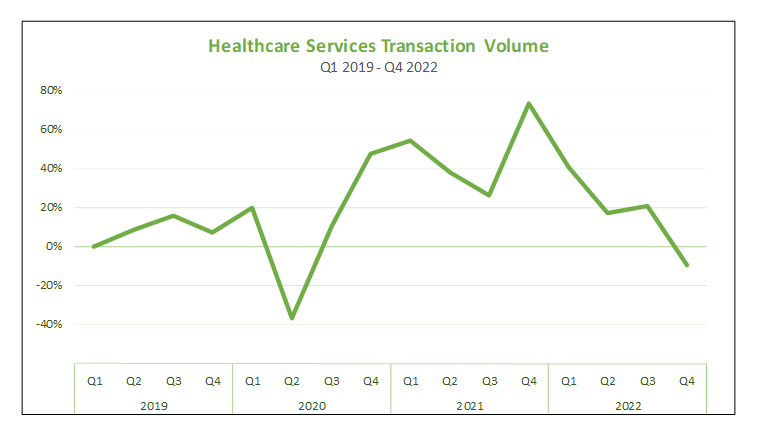Health Care Services Transaction Volume Declines Below Pre-Pandemic Levels
Article
Health care services transaction volume decreased significantly in 2022, decelerating from a blistering pace in 2021.
4 minute read
January 18, 2023
Partner, Financial Advisory
Health Care Valuation Services
Health Care Valuation Services
Managing Director, Financial Advisory
Health Care Valuation Services
Health Care Valuation Services
Never miss a thing.
Sign up to receive our insights newsletter.

Periods of Market Transition May Create Price Dislocation and Fair Market Value Considerations
Health care services transaction volume decreased significantly in 2022, decelerating from a blistering pace in 2021. The transaction data, published by Scope Research., may illustrate growing market dislocation between buyer and seller “willingness and ability” to transact. The most recent data in Q4 2022 show transaction volume settling slightly below pre-pandemic baseline levels.
By the Numbers

The chart above, developed based on data from Scope Research shows:
- Using Q1 2019 as the baseline (0%), health care services transaction volume experienced normal and moderate volatility until the beginning of the pandemic, or Q2 2020.
- Transaction volume plummeted during the pandemic in Q2 2020, down nearly 40% from the baseline.
- By Q4 2020, transaction volume surged, ranging between 40% and 60% above the baseline, partially a function of delayed, rather than cancelled, transactions originally scheduled for Q2 2020.
- Q4 2021 transaction volume accelerated to close to 80% above baseline, a blistering pace of deals hovering well above normal and sustainable levels.
- Transaction volume though Q3 2022 declined each quarter towards the pre-pandemic baseline, and fell below pre-pandemic baseline in Q4 2022. The data is clearly illustrating characteristics of mean reversion.
Why it Matters
- Steep transaction volume declines may signify market price dislocation as the willingness and ability of the buyer and seller to complete the transaction diverge, resulting in many delayed or cancelled transactions.
- Sellers may be less able to demonstrate earnings growth and durability given recent financial performance challenges (i.e. inflation, staffing, etc.), and less willing to accept a lower price (despite recent headwinds) because they are still anchored to yesterday’s price.
- Buyers may be less willing to take risk at historical pricing levels depending on their view of the future and less able to finance high prices with more expensive and scarce debt capital, given interest rate increases.
Health Care Valuation Takeaways
- High quality companies with sustainable competitive advantages will continue to be attractive to well capitalized buyers. In a selective environment, it is important for the valuator to understand seller earnings durability and sustainability when assessing appropriate company risk factors. Current market deal activity will skew transaction volume towards resilient and high quality assets, reflecting a “flight to quality”. The valuator must thoroughly assess qualitative risk factors of the seller and not place an over reliance on recent performance metrics.
- Periods of market dislocation can be challenging for the valuation professional. The valuator should be cautious about using recent transaction volume trends as a comparable transaction guide. They should make adjustments (when appropriate) to account for the higher cost and availability of capital in addition to the impact of cost inflation on seller earnings potential. Booms and busts occur in every industry, and health care services is no exception. The valuator should use caution relying on valuation assumptions including “boom time” data. Taking a long-term sober view of the transaction environment will yield a higher quality valuation conclusion.
- It is unclear whether 2023 transaction volumes will stabilize around baseline levels or continue to decline.
- Professionals involved in health care transaction advisory services will experience lower revenue as transaction volume reverts to historical means. They are likely to experience more competition from new participants who took on the transaction advisory role to exploit elevated market transaction volume.
Dig Deeper
For information about health care provider valuations, contact us. We are here to help.
© 2023
This is one in a series of related health care valuation posts:
- Surgery Outmigration Driving Elevated Valuation Multiples in the ASC Segment
- Increased Contract Labor Costs May Lead to Valuation Revisions
- Revenue Growth and EBITDA Multiple Expansion Drove Historical Health Care Investment Returns
- Expanding Supply of Urgent Care Centers Create FMV Considerations
- Behavioral Telehealth Growth May Mean Opportunities for Inpatient Operators
- The Future of US Health Care Profits
- Hospital Expense Statistics Illustrate Significant Labor Pressures
- Hospital Earnings Supported by Fewer Uninsured Patients

